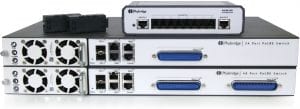Be on the lookout!
Because planning a migration from a legacy digital telephone system to an IP-based phone system solution doesn’t have to be challenging… but it can be daunting if you don’t have the right vendor-partner involved. Who has the experience to help you plan the best approach.
Fortunately for you, we’ve got your back!
As a member of The IDeACOM Network, we have relationships with many of the leading providers, which gives us access to their innovative and award-winning solutions.
So for you, this means we have all the tools and expertise we need to successfully deploy your next phone system.
And one of those tools overcomes a major barrier that many companies (as well as other vendors) face when attempting to migrate to a voice over IP (VoIP) solution.
And that “barrier” is, how to connect the new phones.
 Keep in mind, there are different opinions on how to answer this question. For purpose of this discussion, we’ll refer to them as “options”.
Keep in mind, there are different opinions on how to answer this question. For purpose of this discussion, we’ll refer to them as “options”.
And it bears mentioning that although each situation has its own unique set of challenges, which could include infrastructure, environmental, or budgetary, there are also many similarities between disparate installations.
So let’s first review the different “options”.
- Daisy-chaining one network wire and sharing it between the phone and computer. In a perfect environment, with the right network equipment and IT expertise, this will work. But we are not working in a “perfect environment” 99% of the time. So we need to account for the imperfections.
- Install new category 6 network wiring for the new phones. Sounds logical, right? And it is if you are moving into a new office. But in an existing operation, it’s a costly and very disruptive initiative.
- Don’t’ go for a full-blown VoIP solution. Instead, install a converged digital / IP system, and stay with 2-wire digital phones in the office. DISCLAIMER: I am NOT recommending this option. It is simply an “option” that you may be presented with in the future. In our professional opinion, there is no future for converged digital phone systems. Which begs the question, “Then why should you invest in a converged digital phone system?”. And since most of our clients are installing cloud-based VoIP solutions anyway, purchasing outdated digital technology and installing in your office makes little to no sense.
- VoIP-enable your existing voice wiring. Wherever you have a phone now, new phones can easily be activated, which is not always possible when you deploy VoIP using viewpoint #1 above. Think about conference rooms, convenience areas and warehouse locations where you have a phone but no computer.
Some of the installation variables include:
- Moving to a new office where you will be installing new wiring.
- Installing your new VoIP solution in your existing location.
- The quality and speed of your Internet.
- Other IT challenges including the health of your LAN.
- Your own experiences, perceptions, and budgetary constraints.
Now let’s address each of the 4 options, from an experienced and unbiased perspective. Well, a slightly biased opinion as you will see in Option 3.
- We very rarely daisy-chain one network wire from the wall between your phone and computer.
Why? It can cause “unpredictable results” that will not make you happy.
When do we daisy-chain? First, in very small installations because the potential impact of these unpredictable results is very low. Second, where our client has sophisticated network architecture and the expertise in-house or through their outside IT vendor to properly configure the network to prioritize voice.
- Installing new network wiring for a new location is obvious. We prefer a separate network wire for each phone, but will consider daisy-chaining if you meet the criteria outlined above.
- We cannot endorse investing in a premise-based converged digital phone system.
- VoIP-enabling the existing voice wiring occurs frequently in our upgrade recommendations and installations. Mainly because we are deploying the new VoIP solution in the existing location. It’s easy, it’s disruption-free, and it’s the most cost-effective method. And Phybridge allows us to easily eliminate the infrastructure barriers when migrating to an IP-based phone system platform.
Which leads me to a testimonial for this innovative Phybridge VoIP technology that’s addressed in Option 4.
We have tens of thousands of active Phybridge ports in service, supplying Ethernet and power through existing voice wiring to support new IP phones and other IP endpoints.
 Consider this… Phybridge switches are provider and phone “neutral”. This means the Phybridge PoLRE (Power over Long Range Ethernet) switches will provide a reliable Ethernet connection to your new VoIP phones, while utilizing existing voice wiring.
Consider this… Phybridge switches are provider and phone “neutral”. This means the Phybridge PoLRE (Power over Long Range Ethernet) switches will provide a reliable Ethernet connection to your new VoIP phones, while utilizing existing voice wiring.
The Phybridge switch doesn’t care if you’re using a cloud-based phone system, or a premise-based VoIP server. It also doesn’t care what type of VoIP phones you connect to the network.
How cool is that?
To learn more about this innovative technology as you plan your new VoIP phone system implementation, contact your IDeACOM representative for a complimentary consultation.



Recent Comments